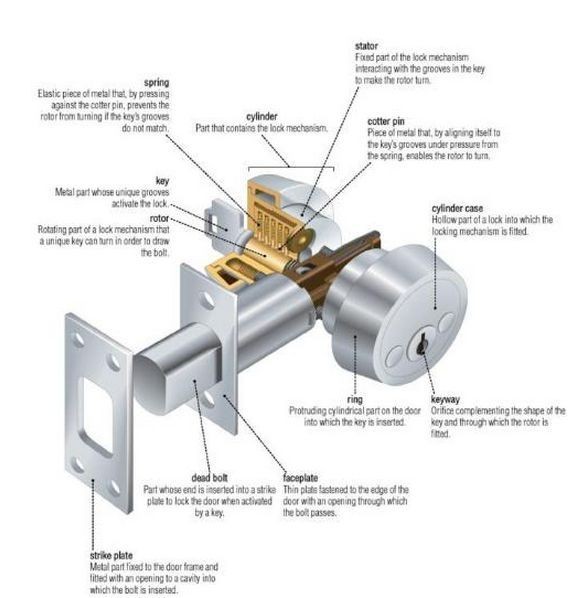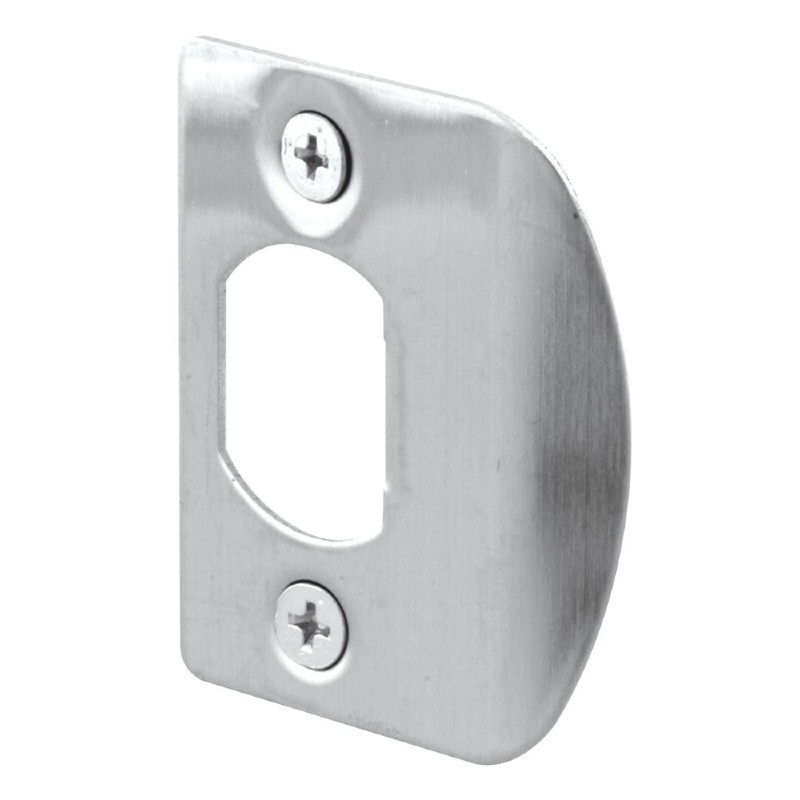The Anatomy of Door Locks: Types, Parts, and How to Choose the Right One
When you think of the anatomy of door locks, traditional door locks are probably what comes to mind. These locks have a keyhole and a manual latch. This description makes door locks seem simple and plain, but they are actually much more complex than what meets the eye. A little research to better understand how each part works can help you fix lock problems on your own and reduce calls to your local emergency locksmith in Houston, TX. Below is an overview of the parts of a door lock and how they work.
Common Types of Door Locks (Quick Overview)
Homeowners can choose from several lock types, each balancing security, convenience, and cost differently. Understanding the options helps you match the right lock to the right door.
Deadbolts vs. Knob Locks: Key Differences
- Deadbolts extend deeper into the door frame and resist forced entry better than latch-only knobs.
- Knob or Lever Locks are fine for many interior doors and as secondary hardware on exterior doors, but they are more vulnerable if used alone.
Smart Locks: Modern Convenience + Security
Smart locks layer convenience onto solid mechanical hardware and can integrate with your home’s ecosystem.
- Remote access via smartphone apps
- Biometrics on select models (fingerprint)
- Smart home integration (Alexa/Google/Apple)
- Temporary codes for guests and service pros
- Activity alerts when doors are locked/unlocked
Note: Smart locks use batteries and may require occasional troubleshooting, but their convenience and auditability make them strong choices for busy households.
The Anatomy Of Door Locks: Traditional & Electronic
Many residential homes, apartments, schools, libraries, small commercial buildings and other similar spaces still use traditional key-and-doorknob locks for both interior and exterior doors. Traditional locks, also known as mechanical locks, while still popular today, are not the only type of lock available. Homeowners and business owners can also choose from different types of electronic locks, many of which are widely available and affordable. These types of locks use electricity and small motorized components instead of the parts found inside traditional locks.
Recently, lock manufacturers have taken to incorporating smart technology into their electronic locks. Smartphone use or voice control are more advanced ways of opening a door that omit the need for a key.
At Express Locksmith Houston, we strive to take care of all of our client’s needs. We know that you probably have questions about the services we provide. That is why we have put together a frequently asked questions (FAQ) page to help you understand our services. Some of the most common questions we get asked include:
What Are the Parts of a Door Lock Called?
Some of the most important parts of a lock include:
The Cylinder: Also called the body, this is the part where the key is inserted. When it is locked, a series of spring-loaded pins are engaged by the cylinder. This keeps the cylinder from turning.
The Bolt: Also called the latch, the bolt engages the inside of the door. There is a piece of metal that extends from the door into the frame itself. This bolt is used to hold it closed.
The Box: The bolt extends from the cylinder into a hole that is designed to fit the bolt perfectly. This is called the box. The box is meant to hold the bolt in place when it is locked. This prevents it from being pulled open.
Essential Lock Components (Additional Terms)
- Strike Plate: Reinforced metal plate on the door frame that the bolt/latch enters, increasing strength at the point of contact.
- Keyway: The slot the key slides into; its profile helps prevent unauthorized keys from turning the cylinder.
- Spindle: The rod connecting knobs or levers to the lock mechanism so turning the handle retracts the latch.
- Thumb Turn: Interior lever that operates the lock without a key (common on single-cylinder deadbolts).
What Are the Parts of a Key Called?
The majority of keys are made up of small pieces of metal that are used to disengage a lock that might be in place. In general, there are two parts to most keys within the anatomy of door locks. The first part is called the bit or the blade. This slides into the lock itself. Locks are shaped to distinguish between various keys so that it only unlocks for the right key.
The second part of the key is called the bow. This is the part that protrudes from the locking mechanism when the key is in place. This allows the user to provide torque to unlock and open. In this manner, the key acts as a security token, allowing users to gain access to specific areas.

What Are the Parts of a Deadbolt?
Some of the most important parts of a deadbolt include:
The Actual Bolt: The actual deadbolt itself is a small piece of metal that extends from the door and into the frame. It locks with the frame to prevent someone from opening from the outside.
The Thumb Latch: This is the part of the deadbolt that extends from the surface. This allows the user to rotate and unlock the deadbolt from the inside.
The Turnpiece: Also called the tailpiece, this is the part of the locking mechanism that extends through the door from the cylinder on the outer key. The thumb latch connects to this piece of the deadbolt allowing the user to operate the lock.
The Keyhole: The Keyhole itself is where the key inserts, allowing users to operate the lock.
These are a few of the most important parts of the deadbolt. Each part plays a role in how the locking mechanism works.
What Is a Door Strike Plate?
The strike plate is the metal that is attached to the doorjamb itself. There is usually a set of holes into which the bolt of the inserts. When the door is closed, the bolt extends into the hole. It is the job of the strike plate to keep it closed. The strike plate itself protects the rest of the structure against friction. The strike plate also increases the amount of security provided. The strike plate itself is made of metal, which is much stronger than the materials that are used to make most doors (such as wood). Many strike plates also have an added security measure that prevents the bolt from being retracted without a lock.

What Is the Plate Behind a Door Knob Called?
The plate behind the door can refer to two separate pieces of metal. The first option is the strike plate, which is discussed above. The strike plate keeps the bolt in place when it is locked. When it closes, the latch strikes the plate and holds it closed.
The anatomy of door locks provide another option called the rosette. This is a plate that is located behind the knobs. The rosette is meant to hold the doorknob in place and prevent it from rattling when the knob is turned. In this manner, the rosette plate adds an extra layer of security and increases the durability of the doorknob.
How to Choose the Right Door Lock for Your Home
The Anatomy of Door Locks Security Options
- Front doors: Grade 1 or 2 deadbolt; consider a smart keypad for convenience.
- Back/side doors: Deadbolt + reinforced strike plate with 3″ screws.
- Interior/privacy: Knob/lever locks are typically sufficient.
Durability & Standards (ANSI/BHMA)
- Grade 1: Highest residential/commercial security
- Grade 2: Strong residential; solid all-around choice
- Grade 3: Basic security for low-risk areas
Ease of Use & Access
- Prefer keys? Choose a reliable single-cylinder deadbolt.
- Hate keys? Consider a smart lock with keypad or fingerprint.
The Anatomy of Door Locks For Aesthetics
Match finishes (brass, nickel, bronze, chrome) to existing hardware for a cohesive look.
Tips for Maintaining The Anatomy of Door Locks
- Use graphite or silicone-based lubricant on moving parts (avoid oil that gums up).
- Tighten loose screws and realign hardware to prevent sticking.
- Reinforce/inspect strike plates and use longer screws into the stud.
- Clean the keyway with compressed air; avoid forcing stuck keys.
- Replace worn keys to reduce cylinder wear and misreads.
Deadbolt vs. Knob/Lever vs. Smart Lock (At a Glance)
| Lock Type | Security | Convenience | Ideal Use | Notes |
|---|---|---|---|---|
| Deadbolt | High | Moderate (key/turn) | Main exterior doors | Choose Grade 1/2; pair with reinforced strike plate |
| Knob/Lever | Low–Medium | High | Interior; secondary exterior hardware | Not a substitute for a proper deadbolt |
| Smart Lock | Medium–High | Very High (codes/app/biometric) | Busy households; rentals; guest access | Mind battery life; pick reputable brands |
Contact Us To Learn More About The Anatomy Of Door Locks!
If you would like to learn more about how we can help you with all of your lock needs, contact us today! Our trained professionals are always standing by to help you answer all of your questions or concerns about the anatomy of door locks and the parts of a lock. We look forward to meeting you!
FAQ’s About The Anatomy of Door Locks
What’s the most secure lock for a front door?
A Grade 1 deadbolt with a reinforced strike plate and 3″ screws into the wall stud provides excellent resistance to forced entry. Pairing with a smart keypad adds convenience without giving up security.
Are smart locks safe?
Quality smart locks are as safe as their mechanical cores. Choose reputable brands, enable updates, use strong codes, and keep fresh batteries. Consider models with tamper alerts and activity logs.
Do I need both a knob lock and a deadbolt?
Yes for exterior doors. The knob/lever provides everyday latching, while the deadbolt supplies real resistance against kick-ins and prying.
How often should I maintain my locks?
Light maintenance every 6–12 months (lubrication, tightening screws, keyway cleaning) keeps locks smooth and extends lifespan.
What’s the difference between a single- and double-cylinder deadbolt?
Single-cylinder uses a key outside and thumb turn inside; easier egress. Double-cylinder needs a key on both sides; more secure against glass-adjacent doors but can slow emergency exits.
Categorised in: House Lock
